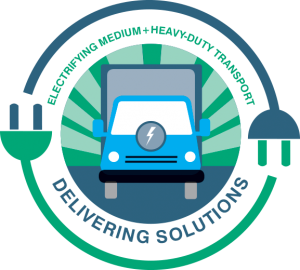 This post is the first in our Innovation Series
This post is the first in our Innovation Series
One of the largest sources of climate pollution is the transportation sector, which is responsible for about a quarter of our nation’s greenhouse gas pollution. It is clear that to reach our climate goals, we must reduce car and truck emissions.
One way to reduce harmful air and climate pollution is by electrifying the transportation sector, especially long-haul trucks, buses, delivery vehicles, garbage trucks and regional “day cab” tractors used at ports. Heavy-duty vehicles are not only responsible for significant climate pollution, they are also responsible for about 30% of Nitrogen oxide pollution. These emissions can increase cancer risk, neurological and metabolic diseases, and cause respiratory and cardiovascular damage.
Toxic air pollutants like these are often hyper-localized, disproportionately impacting low-income communities and communities of color who are more likely to live near major highways, ports, and distribution centers. A recent EDF study of Oakland’s air pollution, for example, observed residents living near one particular freeway (home to much of the city’s diesel fueled traffic) were exposed to concentrations of black carbon 80% higher than a similar road.
Electrifying these medium and heavy-duty vehicles therefore reduces both pollution that harms human health and reduces greenhouse gas emissions from the combustion of the fuel. But making this win-win transition will require significant technological and political support to succeed. Fortunately, a growing number of innovators are adopting and/or developing tools to expand the number of medium- and heavy-duty electric vehicles on the road — ultimately reducing harmful pollution and preserving a clean, reliable and equitable electric grid.
A smarter way to access energy
The cost of charging an electric vehicle can be high, especially for commercial customers who manage large fleets. As an illustration, the battery capacity of an electric bus is typically about 200-300 kilowatts (kWh), versus the Chevy Bolt, which has a capacity of 60 kWh. To adequately charge a heavy-duty vehicle in a reasonable amount of time, rapid chargers are needed, which can cause spikes in demand and lead to high energy costs for customers.
Trucking companies, utilities and innovators work together to put more electric vehicles on the road Share on XFortunately, some utilities have developed a solution: a pricing mechanism that charges customers less for energy when demand is lowest – typically around midday, when there is abundant solar energy generation. Therefore, companies that charge vehicles when energy rates are lowest can reap huge economic and environmental benefits.
Rebates, incentives and lower costs
Currently, there are multitude of other programs that can help offset the cost of vehicles and infrastructure. For example, all of the major utilities in California now have programs and proposals that help ensure the state is developing charging stations to guarantee fleets can charge at their existing depots and have sufficient access to public charging stations. Another California program provides rebates to vehicle purchasers at the time of sale.
The New York utility Con Edison also recently expanded their SmartCharge program in order to encourage the purchase and strategic use of medium and heavy-duty vehicles. Fleet owners who take advantage of these programs, and the policy makers who develop them both play critical roles in reducing the up-front costs associated with electric vehicles.
Embracing technological innovations
A number of emerging technologies can also save companies money and ensure a clean, reliable grid. Some tech can help vehicles dispatch energy they have charged, but are not using, back to the grid and generate new revenue streams for companies. Others, like mobile apps and smart charging stations, can help ease the complexities of charging vehicles in off-peak hours. Embracing these innovative tools can give fleet owners a competitive edge when switching to electric vehicles.
The smartest, most innovative trucking companies successfully manage their fleets as a form of energy storage, take advantage of rebates and incentives, embrace innovation, and provide benefits where they are needed most. As we strive to transition to a much-needed, electrified transportation sector, companies and policy makers are increasingly proving that they are finding ways to make this shift work financially and environmentally.
Over the next several months, we will be profiling the innovators – ranging from small technology developers to long-haul national trucking companies — who are taking advantage of these tools to make the transition to cleaner energy possible.









